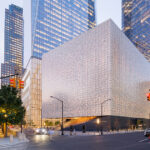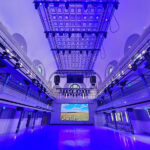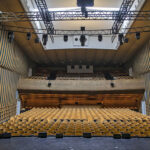Architects building cool, inevitably iconic buildings don’t always think about how the heck the exterior will be lit. At least they probably didn’t in 1963. That year, the James S. McDonnell Planetarium in St. Louis, MO was built by modernist architect Gyo Obata. The planetarium, part of the St. Louis Science Center, is where stargazers can sit reclined in a circle, looking up as the interior and ceiling are lit up to show the solar system.
Although the primary focus was always educational, from 1975 to 1983, at midnight on Friday nights, the planetarium would host a show called Laserium, with electric eye-candy set to pulsating rock music. Along with the visuals and sound, unusual smells would permeate the space (at least that’s what my older brother tells me).
Second to the Gateway Arch, the planetarium, with its thin-shell and hyperboloid structure, is the most distinctive building in St. Louis, and lighting it properly has always been a challenge. John Burkley knows, because he’s done it. Twice.
 Changing Focus
Changing Focus
Burkley was a gaffer lighting for movies filmed in the region, and started Cine Services in Kansas City in 1974. “I started it right after the company I was working for got hit by the feds for not paying taxes,” Burkley laughs.
The job switch prompted his move across the state to St. Louis in 1985. Today, although the bulk of his work is lighting churches for video production, Burkley sets aside some time for architectural projects such as this one.
The Science Center first called on Cine Services in 2002. Back then, Burkley chose 12 exterior wash fixtures with an incandescent light source and dichroic color-changing assembly.
The manufacturer discontinued that fixture only about three weeks after Burkley completed the install. While the fixture’s manufacturer was “very good” at supporting the lights, even after they were discontinued, “the difficulty is that the lamps would explode, and when they do, all those glass filters in the light get severely damaged. It’s a shame, because they looked good, and were effective in making the building change color.”
Although the building’s curving surfaces looked striking when bathed in different hues every night, about five years ago, the museum and planetarium management grew weary of the mechanical breakdowns, steep energy bills and costs of replacing the light sources. Eventually, they pulled the plug.
When management opted to give the aging iconic landmark an update recently, they started with the exterior, giving the planetarium a bright, white coating. Burkley again went after the project, and had a specific tool in mind to do it.
“I had done some testing with the Martin Exterior 400 Image Projector, and I had [Martin project manager] Brad Haynes fly one in,” he says. “I took one over to the maintenance department, and they liked the fixture very much right away.”
The Science Center also gave a video company a chance to see what they could do, arranging a shoot-out of sorts one night in March, 2013. They had Burkley come over with his three Martin 400 IPs and the other company come in with their video mapping equipment. Each lit up half the planetarium.
“It was clear that mine did what was needed, and did it for a lot cheaper,” Burkley laughs. (The video-mapping project was ultimately just being considered for special events; it was not as well suited for long-term daily use.)
As noted, Burkley had tested other fixtures before opting for the Martin 400 IPs. Among the factors clinching that decision — the fixtures’ automatic color changing feature, and the fact that you can rotate the gobos quickly and easily without taking the light completely apart.
“The razzle-dazzle it gives is like no other fixture,” Burkley says. “Each came with six colors and a zoom lens, and it can hold six gobos, so you can create a lot of visual effects with it.”
Another consideration is that the planetarium wanted to be able to switch out gobos. “One of the things that this will allow them to do is create custom gobos to promote events and sponsors,” he says. “With this 400 IP, changing gobos is about a 10 minute process. You pull out the front lens and the entire assembling comes out front, and then you switch out gobos or colors or whatever you want.”
The museum’s lighting designer, Layne Ibel, went over to Burkley’s location and perused the Rosco gobo catalog, choosing a few good multi-purpose designs. (A variety of custom gobos will be created in the future.)
Burkley had initially favored a plan to have a dozen of the 400 IPs, but he adjusted the project with six of the units complemented by 24 Martin Exterior 410 ColorWashes.
The lighting design relies upon a High End Full Boar 4 with Pathway 4- and 8-way DMX Repeaters for control.
Ibel is on record as appreciating the variability and flexibility of the entire system, which he controls from an iPad. “I can go super-crazy and make it a rock concert,” he told the St. Louis Post Dispatch, which did a nice feature on the exterior lighting project when Burkley’s work was revealed in December.
 Milestone Celebrations, Inside and Out
Milestone Celebrations, Inside and Out
The James S. McDonnell Planetarium capped its 50-year anniversary with a spectacular new exterior architectural lighting installation — this time using solid state LED technology instead of a troublesome combo of explosion-prone bulbs with dichroic glass filters (see main story).
Inside, however, the planetarium offered visitors plenty of visual spectacle with a nearly year-long reprise of Laserium, an offshoot of the original planetarium laser shows pioneered by Ivan Dryer at Griffith Observatory in Los Angeles in late 1973.
McDonnell Planetarium director John Lakey, who caught the cosmic light and sound show during its initial 1975 to 1983 run in St. Louis, worked with laserist Brian Wirthlin of Photon Alchemy to bring the show back to town.
Wirthlin also caught Laserium fever early on — he attended the show’s St. Louis premiere as a high school student who worked part-time in the planetarium’s bookstore.
Four years later, Wirthlin was the planetarium’s chief technician. He then got hired by the company that ran the Laserium producer Laser Images, Inc., and served as a laserist for its productions in Chicago and Washington, DC.
By 2004, when Wirthlin started taking steps to bring Laserium back, he wasn’t sure if any of the original show tapes had survived.
As it turned out, they had, and Wirthlin and Lakey started putting the elements together for a full-scale reprise of the show. As such, Laserium in St. Louis marked a dual milestone in 2013 — 50 years for the planetarium, and 40 years for Laserium.


